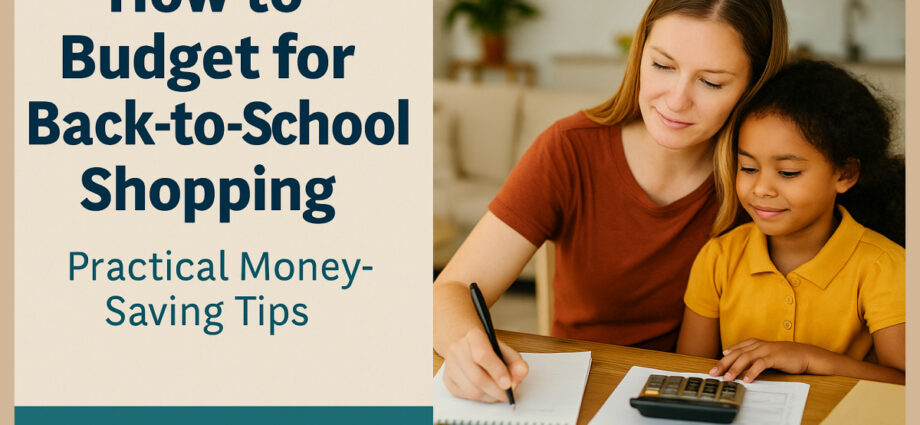Back-to-school season is an exciting time for both kids and parents. It marks new beginnings, fresh opportunities, and the promise of learning adventures. However, it also comes with a not-so-exciting aspect: the expenses. From school supplies to new clothes, the costs can quickly add up. But fear not! With a bit of planning and a well-thought-out budget, you can manage these expenses without breaking the bank.
In this article, we’ll explore practical tips and strategies to help you budget effectively for back-to-school shopping, ensuring a stress-free and financially savvy start to the school year.
How to Budget for Back-to-School Shopping
Before you hit the stores or start filling your online shopping cart, it’s essential to take a step back and understand exactly what you need. This not only helps in avoiding unnecessary purchases but also ensures you make the most of your budget.
Inventory Check
Start by taking stock of what you already have. Gather all the school supplies, clothes, and accessories from previous years. You might be surprised at how many items can be reused. Those gently used notebooks, half-full packs of pencils, or barely worn uniforms can still serve their purpose. This simple step can save you a significant amount of money.
Creating a List of Essentials
Next, make a detailed list of what your child genuinely needs for the upcoming school year. This list should be realistic and focused on essentials. Separate the “needs” from the “wants” to prioritize your spending. For example, new shoes and notebooks might be necessary, while a trendy backpack might fall into the “want” category. Prioritizing helps in managing your budget more effectively.
Taking the time to understand your needs sets a solid foundation for smart shopping. It ensures you’re buying with intention rather than impulse, ultimately leading to better financial decisions during the back-to-school season.
Setting a Realistic Back-to-School Budget
Now that you have a clear idea of what you need, it’s time to set a budget that aligns with your financial situation. A realistic budget helps you manage expenses without unnecessary stress.
Evaluate Your Finances
Begin by assessing your current financial situation. Look at your monthly income, expenses, and any savings you can allocate for back-to-school shopping. Determine a specific amount you can comfortably spend without straining other financial obligations. Remember, it’s essential to stick to this budget to avoid any financial surprises later on.
Research Average Costs
To set a practical budget, it’s helpful to know the average costs of back-to-school items. Research the typical prices for supplies, clothes, and technology. Websites, flyers, and even asking other parents can provide a good benchmark. For instance, according to recent studies, the average family spends around $700 on back-to-school shopping. Use this information to gauge your budget, adjusting based on your unique needs and financial capacity.
Smart Shopping Strategies
With a budget in place, the next step is to shop smartly. Here are some strategies to get the most value for your money.
Look for Sales and Discounts
Timing is everything when it comes to finding the best deals. Many stores offer back-to-school sales, especially during the summer months leading up to the new school year. Keep an eye out for tax-free weekends, clearance sales, and special promotions. Sign up for newsletters from your favorite stores to stay updated on upcoming discounts. Planning your shopping around these sales can lead to significant savings.
Use Coupons and Cashback Apps
Don’t underestimate the power of coupons and cashback apps. Websites and apps like Honey, Rakuten, and RetailMeNot offer a plethora of coupons and cashback deals for various stores. Before making any purchase, search for available coupons or activate cashback offers to save a few extra dollars. These small savings can add up quickly, helping you stay within your budget.
Buy in Bulk
Buying in bulk can be a great way to save money, especially for items that your child will use throughout the year, such as pens, notebooks, and snacks. Consider teaming up with other parents to purchase bulk items and share the costs. Wholesale stores like Costco and Sam’s Club often offer great deals on bulk purchases, making this strategy even more cost-effective.
Maximize Online Deals
Online shopping can be a treasure trove of deals if you know where to look. Websites like Amazon, Walmart, and Target often have exclusive online discounts. Use price comparison tools to ensure you’re getting the best deal. Additionally, take advantage of free shipping offers and bundle deals to maximize your savings.
Online vs. In-Store Shopping
When it comes to back-to-school shopping, deciding between online and in-store options can significantly impact your budget and overall shopping experience. Each method has its pros and cons, so it’s essential to weigh them based on your preferences and needs.
Pros and Cons of Each
Online Shopping:
- Pros:
- Convenience: Shop from the comfort of your home at any time.
- Variety: Access a broader range of products and brands.
- Price Comparisons: Easily compare prices across multiple websites.
- Customer Reviews: Benefit from other customers’ feedback on products.
- Cons:
- Shipping Costs: Potential additional costs if minimum purchase requirements are not met.
- Wait Time: Need to wait for items to be delivered, which may be an issue if shopping last minute.
- Return Hassles: Returning items can be more complicated and time-consuming.
In-Store Shopping:
- Pros:
- Immediate Access: Get items instantly without waiting for delivery.
- Physical Inspection: Examine products firsthand for quality and fit.
- Impulse Control: Easier to stick to a shopping list when you see the total cost in real time.
- Cons:
- Limited Stock: May not find everything you need in one place.
- Time-Consuming: Traveling to stores and waiting in lines can be tedious.
- Limited Hours: Restricted by store operating hours.
Maximizing Online Deals
If you opt for online shopping, here are some tips to get the most out of it:
- Sign Up for Newsletters: Many online stores offer discounts or special promotions for newsletter subscribers.
- Utilize Price Tracking Tools: Tools like CamelCamelCamel for Amazon can help track price history and alert you to the best times to buy.
- Take Advantage of Free Shipping: Look for sites that offer free shipping or try to meet the minimum purchase requirement to avoid extra costs.
- Check Return Policies: Make sure the store has a straightforward return policy in case you need to send something back.
Involving Your Kids
Involving your children in the back-to-school shopping process can be a rewarding experience. It not only makes them feel included but also provides valuable lessons in financial responsibility and budgeting.
Teaching Financial Responsibility
Back-to-school shopping is an excellent opportunity to teach kids about money management. Here’s how:
- Set a Budget Together: Discuss the budget and explain why it’s important to stick to it. This helps them understand financial limitations and prioritizing needs over wants.
- Comparison Shopping: Show them how to compare prices and look for the best deals. This skill will be beneficial throughout their lives.
- Allowance for Extras: If your child wants something beyond the budget, consider allowing them to use their allowance or earnings to buy it. This teaches the value of money and making choices.
Making it a Fun Activity
Transform back-to-school shopping from a chore into a fun activity:
- Shopping Lists: Let your kids help create the shopping list. They’ll feel more involved and excited about the process.
- Decision Making: Allow them to make decisions within the budget. Whether it’s choosing between two types of notebooks or picking out a backpack, this gives them a sense of ownership.
- Make it a Game: Turn shopping into a game by setting challenges, such as finding the best deal or sticking to a certain budget for each category. Reward them with a small treat or privilege if they succeed.
Involving your kids in budgeting and shopping not only makes the process smoother but also equips them with essential life skills. It fosters a sense of responsibility and teaches them valuable lessons about money management that they’ll carry into adulthood.

Tips for Saving Money
Saving money during back-to-school shopping doesn’t have to be a daunting task. By employing a few savvy strategies, you can significantly reduce costs and make the most of your budget.
Second-hand and Thrift Shopping
One of the best ways to save money is by considering second-hand and thrift shopping. Here’s how:
- Quality Finds: Many thrift stores carry gently used or even brand-new items at a fraction of the cost. Look for school supplies, backpacks, and clothing.
- Consignment Shops: These stores often have higher quality items compared to typical thrift stores and are a great place to find gently used clothes and shoes.
- Online Marketplaces: Websites like eBay, Facebook Marketplace, and local buy/sell groups can be treasure troves for second-hand school supplies and clothing.
DIY Supplies and Customization
Getting creative with DIY supplies can be both fun and cost-effective:
- Personalized Supplies: Buy plain notebooks, binders, and folders and let your kids decorate them with stickers, drawings, and washi tape. This can save money and give your child unique, customized supplies.
- Homemade Lunches: Packing homemade lunches instead of buying pre-packaged ones can save a considerable amount of money over the school year. Get your kids involved in planning and preparing their lunches to make it more enjoyable.
Utilize Cashback and Rewards Programs
Take advantage of cashback and rewards programs to maximize your savings:
- Credit Card Rewards: Use a credit card that offers cashback or rewards points on purchases. Be sure to pay off the balance each month to avoid interest charges.
- Store Loyalty Programs: Many stores offer loyalty programs that provide discounts, rewards points, and exclusive offers. Sign up for these programs to save more.
- Cashback Apps: Apps like Rakuten, Ibotta, and Honey can help you earn cashback on your purchases both online and in-store.
Post-Shopping Tips
Once the shopping is done, there are still a few steps you can take to ensure you stay organized and continue to save money throughout the school year.
Sticking to the Budget
Maintaining financial discipline after the shopping spree is crucial:
- Track Expenses: Keep track of what you’ve spent versus your budget. This helps you stay aware of your financial situation and avoid overspending.
- Avoid Impulse Buys: Teach your kids the importance of sticking to the list and budget. This reduces the temptation of impulse purchases that can derail your financial plans.
Organizing Supplies
Proper organization can help extend the life of school supplies and ensure nothing goes to waste:
- Storage Solutions: Use bins, shelves, or drawer organizers to keep supplies tidy and easily accessible. This prevents items from getting lost or damaged.
- Label Everything: Labeling supplies helps kids keep track of their belongings and reduces the likelihood of needing to replace lost items.
Future Planning
Consider future needs and set aside funds accordingly:
- Save Leftover Funds: If you come in under budget, set aside the remaining money for future school-related expenses like field trips, extracurricular activities, or unexpected supply needs.
- Plan for Next Year: Start setting aside a small amount each month for next year’s back-to-school shopping. This way, you’ll have a head start and less financial strain when the time comes.
Conclusion
Navigating the back-to-school shopping season can feel overwhelming, but with a well-thought-out budget and strategic shopping, you can make it a smooth and financially manageable experience. From understanding your needs and setting a realistic budget to employing smart shopping strategies and involving your kids in the process, each step plays a crucial role in staying within your financial limits. Don’t forget to take advantage of money-saving tips like second-hand shopping and utilizing cashback apps. Once the shopping is done, stay organized and plan for the future to ensure you continue to manage your finances effectively.
We hope these tips help you master back-to-school shopping without breaking the bank. For more personal finance advice, practical tips, and money-saving strategies, subscribe to our newsletter. Join our community to stay updated with the latest articles and exclusive content delivered straight to your inbox. Happy shopping and here’s to a successful school year ahead!

